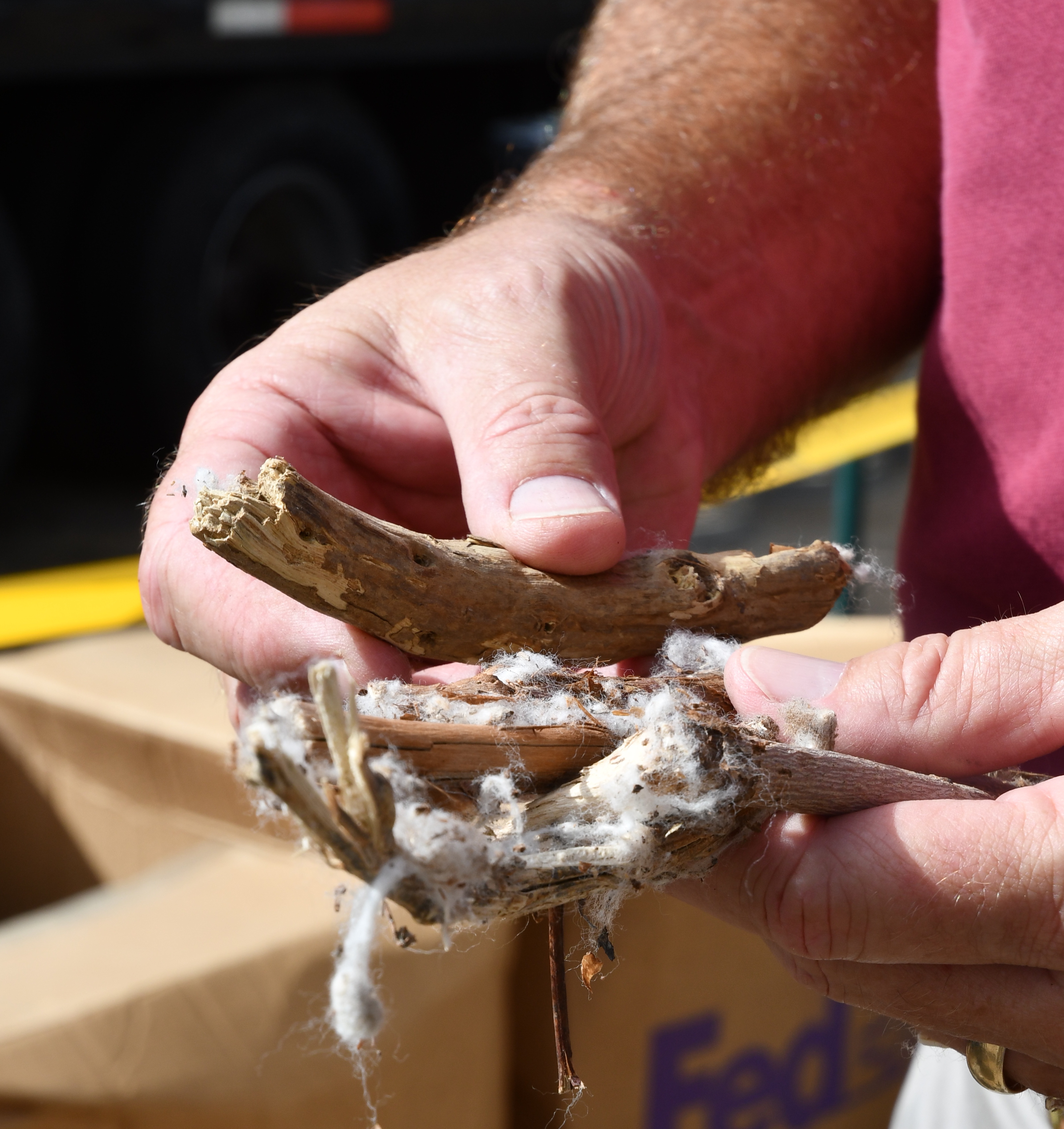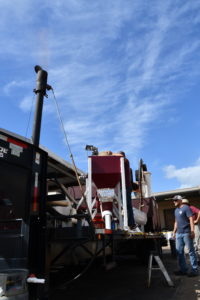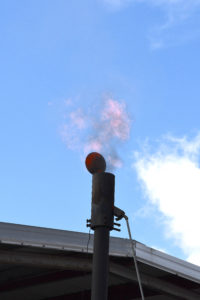Farm & Ranch
[AgriLife Today] Cotton gin trash finding new life for electrical power

By: Blair Fannin
Writer: Blair Fannin, 979-845-2259, [email protected]
Contact: Dr. Sergio Capareda, 979-458-3028, [email protected]
COLLEGE STATION – Finding sustainable markets for gin trash, wood chips and other waste products could be viable in producing more electrical power for a growing global population, according to researchers.
A demonstration was held recently on the campus of Texas A&M University in College Station showcasing a biomass-fueled fluidized bed gasifier, utilizing cotton gin trash and wood chips to power an electric generator. The fluidized bed gasification system was developed in the 1980s when a patent was issued to Drs. Calvin Parnell Jr. and W.A. Lepori, who were both part of the Texas Agricultural Experiment Station now Texas A&M AgriLife Research.
The fluidized bed gasification system was developed in the 1980s when a patent was issued to (left) Drs. Calvin B. Parnell, Jr. and (far right) W.A. Lepori, part of the Texas Agricultural Experiment Station (now Texas A&M AgriLife Research). Cotton gin trash and other biomass feedstocks have been used as fuel to generate heat energy for power production. The technology has been a focal point for (center)Dr. Sergio Capareda, a Texas A&M AgriLife Research agricultural engineer in the department of biological and agricultural engineering at Texas A&M, who researched the technology while working on his graduate degree during the late 1980s. Parnell and LePori were Capareda’s graduate advisors. (Texas A&M AgriLife Research photo by Blair Fannin)
Cotton gin trash and other biomass feedstocks have been used as fuel to generate heat energy for power production. The technology has been a focal point for Dr. Sergio Capareda, AgriLife Research agricultural engineer in the department of biological and agricultural engineering at Texas A&M, who researched the technology while working on his graduate degree during the late 1980s. Parnell and LePori were Capareda’s graduate advisors.
Cotton gin trash is produced in abundance at cotton gins across Texas and usually left unutilized, Capareda said. During harvest season, piles of cotton gin trash can be found at gins throughout the state.
“The process is gasification,” Capareda said. “We limit the amount of air to thermally convert the biomass so the products are combustible gases. These are collectively called synthesis gas. Carbon monoxide and hydrogen, plus a little methane, ethlyene, these are a combustible mixture. Combustible in a sense that you can feed it into an internal combustible engine coupled with a generator so you can turn this fuel into electrical power.”
“It’s easier said than done, because you have to remove the biochar and all the tar in the syngas before it goes into the engine. We have cleaned up the gas very well in this technology.”
The technology converts biomass into electrical power, making it an attractive opportunity for the ag, processing industry and electric utilities.
“For this particular demonstration, we used the conversion of cotton gin trash into electrical power,” Capareda said. “We also used wood waste and turned it into electrical power. With the price of electrical power at 10 cents per kilowatt-hour, the economics are very simple. If you run a 1 megawatt system and sell power for 10 cents per kilowatt an hour, your gross revenue is $1 million. If you find some countries overseas where power is very high, this technology is very attractive.”
A demonstration was held recently on the campus of Texas A&M University in College Station showcasing a biomass fueled fluidized bed gasifier, utilizing cotton gin trash and wood chips to power an electric generator. (Texas A&M AgriLife Research photo by Blair Fannin)
Cotton gin trash and other biomass feedstocks have been used as fuel to generate heat energy for power production. The technology has been a focal point for Dr. Sergio Capareda, a Texas A&M AgriLife Research agricultural engineer in the department of biological and agricultural engineering at Texas A&M, who researched the technology while working on his graduate degree during the late 1980s. (Texas A&M AgriLife Research photo by Blair Fannin) Capareda said the biomass used in the system has to be consistent, meaning whether you are using cotton gin trash or wood chips, it has to be relatively dry and clean without soil, rocks or metals.
“That’s how you begin, make sure it is dry and consistent,” he said. “Then you can run this system 24/7. We need 1.5-2 tons per hour or about 36 tons a day to generate 1 megawatt depending on the type of biomass. High-energy content biomass would need a little less than that. It also depends on heating value and moisture content of biomass.”
Bob Avant, director of corporate relations for AgriLife Research, said
“(This technology) has taken a very evolutionary approach going from a very basic system to one that is computerized. We’re very excited about it and think it has some good applications. We have a number of very big companies interested in this intellectual property.”
Farm & Ranch
Managing Show Cattle Through The Winter

By Heather Welper
Husband and wife duo, Heather and Calvin Welper, are the Co-Owners and Operators or Two C Livestock, located in Valley View, Texas.
The pair’s operation has a show cattle focus where they raise and sell purebred heifers of all breeds and club calf Hereford steers.
When it comes to show cattle, the Welpers know a thing or two including how to prepare for the cold winter months and the Texas major show season run.
To read more, pick up a copy of the November edition of North Texas Farm & Ranch magazine, available digitally and in print. To subscribe by mail, call 940-872-5922.

Farm & Ranch
Double M Ranch & Rescue

By Hannah Claxton, Editor
As the sun rises each day, so do the dozens of mouths that Meghan McGovern is responsible for getting fed. Rather than the sounds of a rooster crowing, McGovern hears the bellows and bleats of a variety of exotic deer, the chortle of kangaroos, the grunts of water buffaloes, and the chirps of a lemur.
Nestled against the banks of the Red River, the Double M Ranch and Rescue, with its high game fences and deer sprinkling the landscape,s its in stark contrast to the surrounding ranches.
“Having deer is kind of like eating potato chips- you can never actually have just one,” said McGovern with a laugh.
McGovern has several herds to take care of- fallow deer, axis deer, water buffalo, goats, and bison. In smaller numbers, there’s also a few kangaroos, a lemur, a potbelly pig, a pair of zebras, a watusi, and a few horses.
To read more, pick up a copy of the November edition of North Texas Farm & Ranch magazine, available digitally and in print. To subscribe by mail, call 940-872-5922.

Farm & Ranch
Acorn Toxicity

By Barry Whitworth, DVM, MPH
With the prolonged drought, most pastures in Oklahoma end up in poor condition. With the lack of available forage, animals may go in search of alternative foods.
If oak trees are in the pastures, acorns may be a favorite meal for some livestock in the fall. This may result in oak poisoning.
Oak leaves, twigs, buds, and acorns may be toxic to some animals when consumed.
To read more, pick up a copy of the November edition of North Texas Farm & Ranch magazine, available digitally and in print. To subscribe by mail, call 940-872-5922.

-

 Country Lifestyles2 years ago
Country Lifestyles2 years agoScott & Stacey Schumacher: A Growth Mindset
-

 Country Lifestyles8 years ago
Country Lifestyles8 years agoStyle Your Profile – What your style cowboy hat says about you and new trends in 2017
-

 HOME8 years ago
HOME8 years agoGrazing North Texas – Wilman Lovegrass
-

 Outdoor10 years ago
Outdoor10 years agoButtercup or Primrose?
-

 Country Lifestyles5 years ago
Country Lifestyles5 years agoAmber Crawford, Breakaway Roper
-

 Country Lifestyles9 years ago
Country Lifestyles9 years agoJune 2016 Profile – The man behind the mic: Bob Tallman
-

 Equine1 year ago
Equine1 year agoThe Will to Win
-

 Country Lifestyles8 years ago
Country Lifestyles8 years agoDecember 2016 Profile, Rusty Riddle – The Riddle Way







